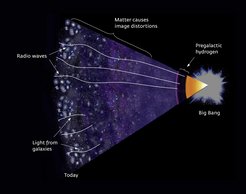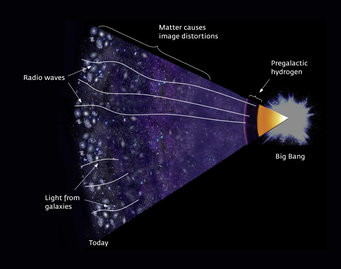Mapping the sky
The universe is full of matter, both visible and, above all, invisible. On its way to us, the light from distant galaxies must traverse space and is diffracted by the gravity of the matter contained therein. This kind of gravitational lensing effect distorts the images – the cosmic landscape looks as if it were being viewed through a carelessly polished piece of glass. When as many distortions as possible have been observed, conclusions can be drawn about, for instance, the mass of the matter in space between us and the distant galaxies.

The more of these light sources are observed, the more accurate this technique becomes. The best telescopes reveal some 100,000 background galaxies in a section of sky the apparent size of the full moon. To reliably determine the image distortion caused by gravity, the astronomers need the light from 200 different galaxies. This means that the smallest area on which the “lensing” mass can be determined corresponds to a size of 0.2 percent of the surface area of the full moon.
That may seem like little, but translated to the dimensions of space, such a section shows only very coarse structures, such as the largest galaxy clusters. Furthermore, it becomes that much more interesting for the cosmologists the further back in time they can look. To do this, however, the background objects must be as far away as possible, which means that they have only a very weak glow and are thus difficult to observe.
An alternative to background galaxies should therefore meet three conditions: they should be distant, easy to observe and numerous. For this reason, Ben Metcalf and Simon White from the Max Planck Institute for Astrophysics in Garching proposed radio waves from a time when the galaxies weren’t yet even born. It seems this radiation really does exist: some 100 million years after the Big Bang, the first stars and galaxies formed from inhomogenities in the neutral hydrogen gas. Their UV light heated up the gas, which then emitted radio waves with a wavelength of 21 centimeters. Since then, space has expanded – and with it, the signals should have grown to wavelengths of 2 to 20 meters.
According to the standard model of the Big Bang, the pregalactic hydrogen exhibited various structures, such as node-like swellings from which galaxies later formed. The pattern of the structures imprinted itself on the signals: according to Metcalf and White, there should be as many as 1,000 such structures at various distances. A radio telescope ought to be able to distinguish them and to create, from the distortions of the signals, a map of the large-scale distribution of cosmic matter. Its resolution would be 20 times better than the maps obtained using background galaxies.
There’s just one catch: the radio telescope would have to be very large and occupy an area of 1,000 square kilometers – about 100 times as much as the central receiver of the new electronic telescope LOFAR (MaxPlanckResearch 4/2010, page 6). But in a few years, “fiction” could become “science”: as Ben Metcalf and Simon White have shown, the planned SKA radio system, with a collection surface of one square kilometer, should already be able to investigate, for example, the mysterious dark energy with greater precision than any instrument before it. Maybe the researchers would then be close to solving one of the greatest cosmological mysteries and would know what is driving the world apart at its core. Helmut Hornung
